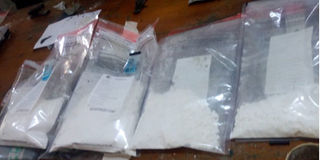Cocaine enters Kenya through Mombasa Port, Eldoret Airport - report

Some of the cocaine from Brazil seized in Mombasa on August 3, 2019. The port of Mombasa and the cargo handling airport in Eldoret are cited as major nodes for cocaine imports into the country.
A new report shows that the cocaine being used and smuggled via Kenya could be much more than what is seized by authorities, despite the drug ranking amongst the least abused in the country owing to its high price.
The latest report by Global Initiative against Transnational Organised Crime (GI-TOC) now tabled before Parliament by the National Authority for the Campaign Against Alcohol and Drug Abuse (Nacada) on the status of alcohol and drug abuse control in Kenya indicates that seizures for cocaine had dropped over the years between January 2017 and June 2021 due to the cost of acquiring the drug, thus making its use minimal and only affordable by affluent Kenyans.
However, the report by GI-TOC dubbed “A powder storm; The cocaine markets of East and Southern Africa” now shows that the number could be more than what is declared as new markets emerge in the drug’s transit countries in Africa, including Kenya.
This, according to the report, has been occasioned by a growing shift away from the US as the destination market of choice, to countries in Europe.
“This has been enabled by maritime and air supply chains that allow the efficient movement of commodities direct to European Union (EU) ports and cities, but also through an apparent resurgence of traffic through indirect traffic supply routes in the African countries along the Atlantic coastline, which are vulnerable to exploitation and well located for transit from other regions,” the report notes.
The report cites the port of Mombasa and the cargo handling airport in Eldoret as major nodes for cocaine imports.
“There is strong evidence indicating that the Nairobi market, fed by cocaine supply chains through the Eldoret air hub, maintains a strong reciprocal cocaine trafficking relationship, along overland traffic links with Mogadishu, Addis Ababa, Juba, Kampala and Dar es Salaam,” the report notes.
It adds that Kenya is also a significant micro-trafficking point for the distribution of cocaine by air and sea to the Indian Ocean island states of Mauritius, Seychelles, Comoros and Madagascar.
Furthermore, the report adds that coca cultivation and potential cocaine production expanded during the first year of the Covid-19 pandemic in its three primary cultivation countries of the Andean production region of Bolivia, Peru, Venezuela and Colombia and that it’s market routes remained resilient despite the measures put in place to curb the spread of the pandemic.
GI-TOC interviewed cocaine abusers, traffickers and law enforcement officers from Eswatini, Lesotho, Kenya, Malawi, South Africa and Tanzania and revealed that cocaine seized in the region does not reflect the state of its flow to and within the East and Southern Africa region where its use and trafficking is a vast enterprise sustained by systemic corruption and complicity.
Kenya, as an indirect supply route for cocaine, enables a wider market for the drug even as Nacada shows that instead, it’s the use of heroin that has penetrated counties previously not ranked as traditional demand zones for the drug. These are; Nakuru, Kiambu, Uasin Gishu, Kisumu and Isiolo and that demand in the country is growing.
GI-TOC notes that in 2020 alone, there were an estimated 10,000 Kenyans abusing cocaine, each consuming 0.3 grammes a day.
The organisation says most cocaine users in Kenya go for the powders whose price ranges between Sh5,250 and Sh7,000 for 0.1 grammes depending on where it’s bought as opposed to the injectable.
The drug is cheapest in Lamu and the price increases as it is peddled deeper into the country, with urban centres located far from the coastal cities and Nairobi paying more.
According to Nacada’s records, only 0.085kg of cocaine was seized by the Kenya Airport Police Unit at the Jomo Kenyatta International Airport between January and June last year.
Another 0.1 grammes was seized in Isiolo and a suspect arrested and undisclosed amount was also seized in Nairobi and Taita Taveta where four and two suspects were arrested with six and three sachets respectively.
The availability of the drug in Kenya could also be enabled by its wide availability in the neighbouring Tanzania, where the report indicates that it is prevalent in the coastal cities of Dar es Salaam and Zanzibar as well as the Tanzania-Kenya tourist border area of Arusha.
To rake in more profits, the report says the smugglers add filler material or other bulking agents to reduce the purity and increase the volume of powder for distribution.





